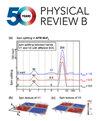Resolving competition of charge density wave and superconducting phases using the matrix product state plus mean field algorithm
IF 3.7
2区 物理与天体物理
Q1 Physics and Astronomy
引用次数: 0
Abstract
Materials with strong electronic correlations often exhibit a superconducting phase in close competition with other insulating phases, which is outstandingly difficult to resolve, e.g., for a group of quasi-two-dimensional (Q2D) materials such as the cuprates, even for the simplified minimal model of these materials, the doped 2D Hubbard model. The present work shows how quasi-one-dimensional (Q1D) systems, 2D and three-dimensional (3D) arrays of weakly coupled 1D correlated electrons, are much more amenable to resolving such competition, treating both instabilities on equal footing. Using the recently established matrix product state plus mean field (MPS+MF) approach for fermions [Bollmark , ], we demonstrate that large systems can be reached readily in these systems, which opens up the thermodynamic regime via extrapolation. Focusing on basic model systems, 3D arrays of negative-求助全文
约1分钟内获得全文
求助全文
来源期刊

Physical Review B
物理-物理:凝聚态物理
CiteScore
6.70
自引率
32.40%
发文量
0
审稿时长
3.0 months
期刊介绍:
Physical Review B (PRB) is the world’s largest dedicated physics journal, publishing approximately 100 new, high-quality papers each week. The most highly cited journal in condensed matter physics, PRB provides outstanding depth and breadth of coverage, combined with unrivaled context and background for ongoing research by scientists worldwide.
PRB covers the full range of condensed matter, materials physics, and related subfields, including:
-Structure and phase transitions
-Ferroelectrics and multiferroics
-Disordered systems and alloys
-Magnetism
-Superconductivity
-Electronic structure, photonics, and metamaterials
-Semiconductors and mesoscopic systems
-Surfaces, nanoscience, and two-dimensional materials
-Topological states of matter
 求助内容:
求助内容: 应助结果提醒方式:
应助结果提醒方式:


